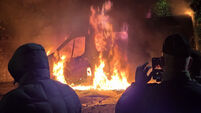Toy story warns that it isn’t all fun and games
IT’S a scene that is played out every day of the week in fields, parks and housing estates, on pavements, in schoolyards and backyards. A gun-wielding cop is chasing a fleeing robber. He raises his super-duper, turbo-charged firearm and takes aim. Within seconds, the robber has dropped, ‘dead’ as a dodo.
For most parents it is a relief to see that, despite so many solitary electronic playthings, their children still like to engage in a bit of rough and tumble. Every kid on the block has heard someone go ‘bang, bang, you’re dead’ at one time or another and most of the time it’s harmless fun. The only thing that gets hurt is a little pride in being caught off-guard by the ‘gun-wielding’ super-hero.
Yet there are times when even the tiniest tots can do serious harm.
That’s something that was brought home to Tina Harris when her 12-year-old daughter Charlotte nearly lost an eye after being hit by a child’s pellet gun.
Charlotte was playing with friends outside her home in Dundalk recently when two younger boys began to chase her.
“She must have turned around and one of the plastic pellets hit her in the eye. We didn’t realise at first that she had been hit and it was about 45 minutes later that she became unwell and I noticed that her eye was bloodshot and she was drowsy.
“It’s just luck that Charlotte didn’t sustain a more serious injury or long-term damage to her eye.”
While the gun the little boys had was plastic, not metal, the pellets could have easily caused a far more serious injury.
Pellet guns are banned from sale in Ireland, but are freely available. They can be bought in any toy store in Spain or Portugal and most get imported in family luggage, despite the practice being illegal.
The Consumers’ Association of Ireland is currently engaged in a survey of toy safety. According to director Dermot Jewell, any parent or guardian should make themselves familiar with the various EU and Irish safety marks, in particular the ‘CE’ mark.
Yet even that will not guarantee absolute safety.
“Some toys, while bearing the safety CE mark and the correct labelling, might still be unsafe, especially if children under three years of age have access to toys designed for older children,” he said.
However, the CE mark only represents the lowest level of safety requirement.
“You have to understand that it is not God’s gift to safety,” says Mr Jewell.
“Last year there was concern about a paint-ball gun. It was sold with full safety approval but the problem was that, while the regulation included a notice of a requirement to wear goggles, there was no mention of what happens when someone not wearing goggles is hit.
“There is always a danger with some of these toys, particularly if they are like a gun or projectile.”
The astonishing thing about the paint-ball product was that it was sold as a toy, yet when gardaí put it through a series of ballistic tests it failed each one of them on safety grounds.
New safety measures came into effect in 1990 in all EU member states, including Ireland, to ensure the free movement of safe toys within the community.
All toys on sale, or given away free, must carry the CE mark.
The mark is an assurance that the toy complies with the relevant Irish and European standards of safety in design.
The CE mark is an assurance that the toy is reasonably safe, bearing in mind the normal behaviour of children and, of course, that the toy is used as intended. There may also be the mark IS: EN71, which is an Irish technical standard of safety, together with the CE mark. Either mark ensures a high degree of safety compliance for the toy, as long as it is used as intended.
Particular care should be taken when buying a toy with electrical parts or a transformer. No electrical toy exceeding 24 volts may be sold or given as a gift in Ireland. Electrical toys should be properly insulated and protected.
When you are buying toys, also keep in mind the age appropriateness of a particular product. A chemistry set suitable for a 10-year-old child could prove fatal in a toddler’s hands. So look at the label for instructions plus advice on the safe use of the toy.
Most of us are aware of the range of toys available once a child hits the age of three. Before that so many seem to say, “Not for children under 36 months”. This isn’t written as a killjoy - it’s to help keep your child safe. Small parts can cause choking.
Apart from toys with small parts, check that eyes, noses and ears on soft toys are firmly attached, and babies under the age of one should not have soft toys with long hair or fur. They tend to suck on their toys and could choke on a mouthful of hair.
Safety instructions on electrical toys should be clear and precise. If you come across a toy that appears substandard, don’t buy it and contact the Office of the Director of Consumer Affairs. However, that office does not have a list of dangerous toys and simply advises parental vigilance.
So, despite a tranche of domestic and EU regulations in the past decade, good old common sense and vigilance are the keys to child safety when it comes to selecting toys for Christmas.
“It realistically comes down to parental guidance and control,” Mr Jewell said.
“You have to use the precautionary principle. Parents need to supervise and make sensible decisions if they think a toy may cause problems.”
Many toy manufacturers habitually put warnings on their products, advising that the toy requires parental supervision. But, that, he says, may have little to do with their concerns for child safety.
“Most of these are, disclaimers, done for legal reasons. They are a cop-out.”
For more information, contact the Office of the Director of Consumer Affairs: tel 01 4025555 or 021 274099.
On any label or packaging for a toy you should find the following information:
Trade mark and address of the manufacturer, agent or importer within the EU.
The CE mark for safety.
Instructions for use, if any.
Advice on the safe use of the toy.













